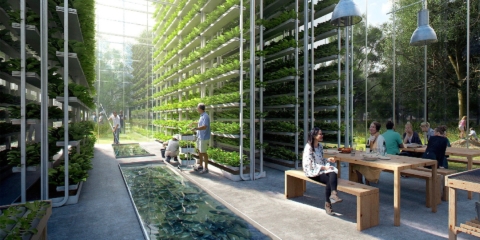Would you like to get notifications from Christian?
It takes around 15,000 bricks just to build a house. A K-Briq has only 13 percent of the carbon footprint of a regular brick. Kenoteq is a closed-loop circular economy company looking to recycle, reuse, and make new innovative and sustainable building products. K-Briq, their flagship product created during research at Heriot-Watt University, is a construction brick made from 90 percent construction waste. It also sits at only 13 percent of the carbon impact and is fully recyclable back into future K-Briqs.
K-Briq uses 90% recycled raw materials, including waste ceramics, roof tiles, porcelain toilets, and fireproof clays. These materials would otherwise be sent to landfills where they would release harmful toxins and methane gas – a greenhouse gas 84 times more potent than CO2 over a 20-year timeframe. To make one K-Briq, it takes just 2 kilowatts of energy, while a traditional fired brick requires 60 kilowatts. The manufacturing process also emits 80% less carbon dioxide than firing bricks in a kiln, making them one of the most sustainable construction products on the market today. K-Briq is made using a process called hydroforming which molds the bricks underwater under high pressure without applying any heat, meaning that no energy is required to produce them – making them genuinely zero-carbon.
K-briq offers many benefits over traditional fired bricks, including being lighter (17% of the weight), more robust (7% higher compressive strength), and more thermally efficient (30% poorer thermal conductivity). As they are made from recycled materials, they are also much cheaper to produce, costing just 60% of what it costs to make fired bricks.
As K-briq are non-toxic, they do not release harmful chemicals or pollutants into the environment. They are 100% recyclable back into future K-Briks – creating a closed-loop product life cycle that is unprecedented in the construction industry.
The sustainability benefits don’t stop there; as K-briq are so thermally efficient, they can help reduce your energy costs by keeping your home or office cooler in summer and warmer in winter – saving you money on your energy bills!
Kerran Grieve, Founder & CEO of Kenoteq, said: “Our ambition has always been to provide an ethical alternative to conventional construction products that don’t cost the earth – quite literally. We’re on a mission to change the way buildings are constructed for future generations, and our ground-breaking technology does just that” “The embodied carbon in buildings is responsible for 11% of global emissions, so it’s clear that we need to find more sustainable ways of constructing our built environment if we want to stand any chance of reaching net zero by 2050″ “We need to rethink the way we build and move towards using more recycled materials in construction as this will help us close the loop on waste while reducing our impact on the planet.”
With global emissions from buildings accounting for 11 percent of all emissions, it’s clear that we need to find more sustainable ways to construct our built environment if we want to stand any chance of reaching net zero by 2050. By producing bricks made from 90 percent recycled construction waste, Kenoteq is helping lead the charge toward more sustainable construction practices that will help preserve our planet for future generations.
Author: Christian Kromme
First Appeared On: Disruptive Inspiration Daily
Christian is a futurist and trendwatcher who speaks about the impact of exponential technologies like AI on organizations, people, and talents. Christian tailors his presentations to your audience’s specific industries and needs.




Embracing the advancements of technology and AI can enhance our humanity. We can focus on developing our unique talents and skills by automating mundane tasks and freeing up our time. As humans, we can adapt and learn, allowing us to evolve and stay relevant in a rapidly changing world constantly.


Organizations will need to be more fluid, dynamic, and adaptable: the ability to change and adjust in response to new situations and environments. We are on the cusp of a new era of organizations, ones that are more fluid and agile and which behave like swarms we see in nature.




In the future, 3D printing and generative design will allow for products to be designed in a more decentralized manner, and production will take place closer to the customer and fully on-demand. 3D printing technology will also allow for more customization and personalization of products.


The agricultural industry is ripe for disruption. Robotics, AI, and IoT are all technologies that have the potential to radically transform the way we grow food. In combination with vertical farming, these technologies could increase the efficiency and quality of agricultural products.

A human-centered society is one that puts people first and where technology is used to unite and empower people. It is a society that values biological life and dignity above all else. It is a society that recognizes the importance of human relationships and works to strengthen them. In a human-centered society, all members of the community are valued and treated with respect.


The future of healthcare is here. New technologies like AI, IoT, big data, and smart sensors make it possible to become the CEO of your own health. Imagine that your phone can listen to your voice and AI algorithms can detect small nuances in the tone of your voice that indicate specific diseases.
